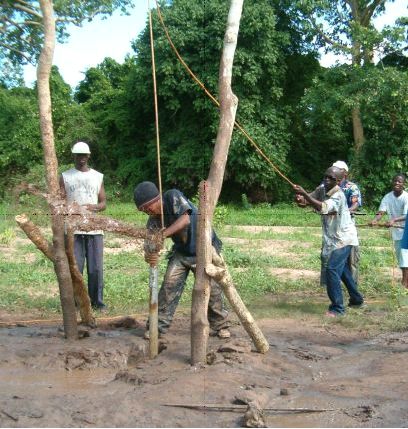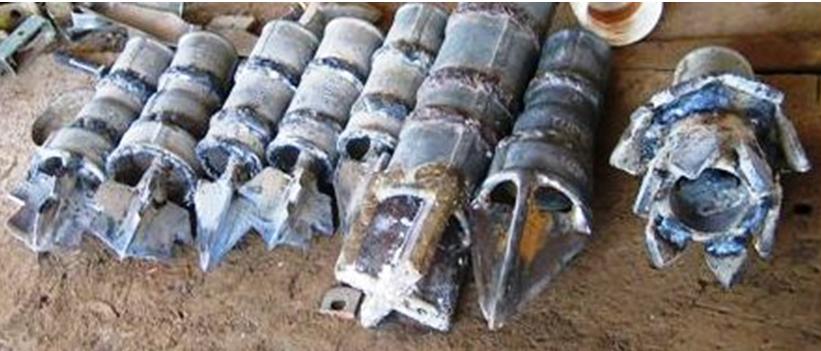Sludging - Baptist method
The Baptist method is a manual drilling method based on the Asian Sludge method. The method was developed to be used by very poor villagers in developing countries, who quickly learn how to drill their wells themselves. The Baptist drilling rig can be built in any ordinary arc welding workshop and materials for a basic version costs about 150 US$ (2006 prices).
History and social context
The method was developed by Terry Waller, a North American Baptist missionary, in Africa and Bolivia. It applies some of the same principles used in mechanized commercial well drilling, but does so using the simplest, most available and cheapest possible materials.
Rural people in developing countries often cannot afford to have specialists drill or dig wells for them. This method was developed to provide poor people with a way to help themselves with their water supply. Having built their own well and pump, users become independent from external help for their water supply.
Suitable conditions
Suitable for unconsolidated formations: Sand, silt and clay. If rotated (including a drill bit) it may be possible to penetrate softer-consolidated formations such as stiff clays, soft sandstone, and weathered laterite. It will not, however, penetrate hard igneous rock or boulders (e.g. in ancient river beds).
In the unconsolidated formation types of Bolivia wells are drilled to depths of 20 and 60 meters on average. In the consolidated formations of Nicaragua, Ethiopia and Kenya well depths range from 10 – 15 meters on average. In exceptional conditions, boreholes up to 100 m deep have been drilled with this method.
| Advantages | Disadvantages/limitations |
|---|---|
| - Very simple and cheap equipment. - Easy to handle and a temporary casing is normally not needed. It is possible to construct the drilling equipment locally. |
- The borehole stays open by water pressure. To prevent collapsing, fluid-drilled boreholes must be kept full of water during the entire drilling and well installation process. - Coarse gravel and other highly permeable materials (cracks in the formation) cause loss of working water and cannot be drilled. If very fine sands (quick sands) are encountered in the first three meter of the borehole, a temporary casing and swell clay are needed on the outside of this casing to prevent collapse. |
Technical specification
Operation
The Baptist drilling process work with pure impact action, there is no rotating movement. Because there is no torque on the drilling stem, a light drilling stem can be used, such as thick-walled PVC pipe. The light drilling stem permits pulling the tool up with a simple pulley fixed to any kind of tripod or crossbeam.
Like in sludging, the drilling process is continuous: the drill bit is normally not removed from the borehole until it is finished. The broken-up material is pumped to the surface in the drilling liquid (mud), so there is no need for a separate mud pump. Instead of using a hand as a valve on top of the drill pipe, as is the case for sludging, the drill bit itself doubles as a foot-valve. The operator’s hand does not have to reach the end of the drill pipe, which means drill stem extensions can be several meters long.
Percussion action is performed by lifting the drill stem with a rope over a pulley, attached to a simple derrick, made with whatever available wood or bamboo poles.
The borehole diameter is kept as small as possible in order to remove a minimum of material and hence advance rapidly. Drill bits are based on 1¼” (32 mm) internal diameter galvanised iron plumbing accessories and the well is cased with cheap 1½” (39 mm) PVC pipe (SDR 41 – drainage quality). Such casing can accommodate up to a 1¼” (external diameter) PVC piston pump.
The main drill tool consists of a 3 m length of 1¼” (32 mm) iron or galvanized pipe with a bit/valve. For extensions of the drill stem, ordinary plumbing PVC pipes (SDR 26) with glued-on thread adapters have been used successfully in holes up to 30 m deep. Over 100 m depths have been reached using heavier PVC pipes (Schedule 40 or 80), and cutting thread directly into the pipe. The use of PVC drill stem keeps total weight of the rig low, even in deep holes. Therefore, no lever is needed to lift it and stroke-length can exceed a metre if so required. The PVC drill stem also significantly reduces the cost of the equipment. On the other hand, it excludes the use of rotary action.
No temporary casing is used. The borehole being kept full of mud and the “caking” of mud into any unstable sand layers, as a consequence of the percussion action and friction of the smooth lateral edges of the bit, is normally sufficient to stabilize it. Drilling mud is evacuated from the borehole after casing the well by pouring or injecting water into the casing (backwashing). This technique adapts best to sand, loam and light rock. The standard drill bits also work through sticky and even consolidated clays. Nevertheless, best results in varying conditions are obtained with an array of different bits:
- Moveable point bits for general purpose and clay-holding soils: the moving stem of the heavy dart helps to keep the footvalve clean.
- Fixed point bits for sandy and rocky layers, where there is no risk for sticky material to obstruct the footvalve.
- Open-ended (hollow) bits without a footvalve (pure sludging) for layers of pure clay or gravel. In these conditions the presence of a footvalve may slow down progress, since clay has to be pounded into suspension and stones have to be ground to small pieces in order to enter the drilling tool through the footvalve.
Reaming
If required, the upper part of the well can be reamed and cased with larger diameter pipe (3 or 5 inches), to accommodate larger pumps. A shallow (large diameter) rope pump, for example, may require a wider well (although small-diameter rope pumps can fit in a 2" borehole), and submersible pumps commonly need at least 4".
Note that there is no need to enlarge the entire depth of the borehole: reaming until slightly below the lowest expected water table (the pump's water intake) is sufficient.
Maintenance
Manufacturing
Cost
A Baptist drilling rig, fit to drill holes up to 30 m deep, can be built in Nicaragua for about US$ 150. This includes all essential non-common tools to operate it. Its core element, the drill bits, can be made in about any arc-welding workshop, using only scrap steel and materials that can be found in virtually any hardware store.
Once the well is drilled, it is cased with cheap PVC tube. Fitting it with a slab of concrete as a sanitary seal and a simple PVC piston pump (also built by the users themselves) will cost about 2.5 dollars per meter well depth.
Country experiences
Baptist well drilling is used in Bolivia, Nicaragua, Kenya, Ethiopia, Mozambique, Cameroon, Zambia and Sri Lanka.
Manuals
Movies / presentations
- Complete set of movies on Baptist well drilling, compiled by Paul Cloesen.
- Video on Baptist well drilling on Water for All international.
- Powerpoint presentation on Baptist Drilling by Terry Waller.
Acknowledgements
- The basis for the material on this page was obtained from a desk study shortly to be published on the website of the Practica Foundation, and from the Rural Water Supply Network, and specifically its manual drilling section.
External Links
- http://waterforallinternational.org/drillingoverview.aspx Water for All - Website of Terry Waller on Baptist well drilling]
- Rural Water Supply Network, article on Baptist drilling. General manual drilling section of RWSN website.
- Technical note 43. Simple drilling methods, Bob Elson and Rod Shaw, WEDC - An overview of simple drilling methods Download. Website of Loughborough University Technical Briefs section. Website of Loughborough University WELLS.
References
- The Wikipedia article on Baptist Drilling, orginally written by Paul Cloesen.

|






